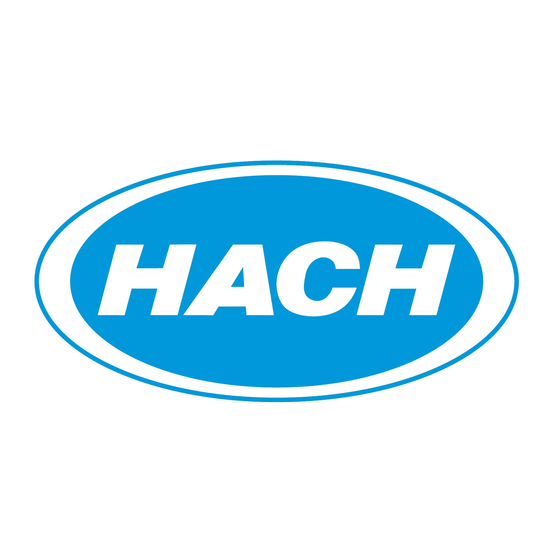
Advertisement
User Manual
®
BOD LDO
Probe: Model LBOD10101
Safety information
Precautionary labels
Electrical equipment marked with this symbol may not be disposed of in European public disposal systems after 12
August of 2005. In conformity with European local and national regulations (EU Directive 2002/98/EC), European
electrical equipment users must now return old or end-of-life equipment to the Producer for disposal at no charge to
the user.
Note: For return for recycling, please contact the equipment producer or supplier for instructions on how to return end-of-life
equipment, producer-supplied electrical accessories, and all auxillary items for proper disposal.
Specifications
Specifications
Probe type
% saturation resolution
% saturation accuracy
Dissolved oxygen range
Dissolved oxygen accuracy
Stabilization time
Temperature resolution
Temperature accuracy
Pressure resolution
Pressure accuracy
Operating temperature range
Storage temperature range
Minimum sample depth
Dimensions
Cable connection
Product overview
Read all labels and tags attached to the instrument. Personal injury or damage to the
instrument could occur if not observed.
Note: Specifications are subject to change without notice.
Details
Luminescent dissolved oxygen (LDO) sensor with integrated stirring system
0.1%
±0.59% of reading
0.05 to 20.0 mg/L (ppm) 1 to 200% saturation
±0.05 mg/L for 0.0 to 10 mg/L
±0.1 mg/L for greater than 10 mg/L
T90% at 10 seconds (when stirred)
0.1 °C (0.18 °F)
±0.3 °C (±0.54 °F)
5 mbar (0.5 kPa)
±3 mbar (0.3 kPa)
0 to 50 °C (32 to 122 °F)
5 to 40 °C (41 to 104 °F)
10 mm (0.394 in.)
Diameter: 12 mm (0.47 in.)
Length: 103 mm (4.1 in.)
Total length: 220 mm (8.66 in.)
Cable length: 1.8 m (5.91 ft)
M12 digital output and connector compatible with HQd meters
The LBOD10101 probe is a luminescent dissolved oxygen (LDO
stirring system
(Figure
1). The LBOD10101 measures the dissolved oxygen for BOD
(Biochemical Oxygen Demand) determination in BOD bottles. The probe uses the
luminescent dissolved oxygen (LDO) technology (no membranes) and features a
replaceable self-stirring assembly and a 1.8 meter (5.91 ft) cable.
DOC022.53.80025
®
) sensor with an integrated
1
Advertisement
Table of Contents

Summary of Contents for Hach BOD LDO LBOD10101
- Page 1 User Manual DOC022.53.80025 ® BOD LDO Probe: Model LBOD10101 Safety information Precautionary labels Read all labels and tags attached to the instrument. Personal injury or damage to the instrument could occur if not observed. Electrical equipment marked with this symbol may not be disposed of in European public disposal systems after 12 August of 2005.
-
Page 2: Preparation For Use
Figure 1 Probe overview Probe cap and seal Stirrer On/Off switch Thermistor Power indicator LED Stirrer assembly Pressure sensor module ® Stirrer paddle iButton compartment Probe body with integrated stirrer Preparation for use Note: Do not touch the probe cap with a hand, fingers or any surface that can scratch the cap. Prepare the probe for use before calibration or sample measurement. - Page 3 • % saturation or mg/L calibration methods are available in the Modify Current Settings menu. • The slope value is the comparison between the latest calibration and the factory calibration shown as a percentage. • The calibration is recorded in the probe and the data log. The calibration is also sent to a PC, printer or flash memory stick if connected.
- Page 4 1. Fill a BOD bottle 2. Add 300 mg of 3. Add 2 mL of 4. Put the stopper 5. Remove the full with deionized sodium sulfite to cobalt chloride in the bottle and stopper. Put the water. the bottle. solution to the turn the bottle over LBOD probe in the...
-
Page 5: Measurement Procedure
• Air bubbles under the sensor tip when submerged can cause slow response or error in measurement. If bubbles are present, gently shake the probe until bubbles are removed. • If a measurement error occurs, refer to Troubleshooting on page 8. Measurement procedure: 1. - Page 6 Table 1 Parameter-specific settings Setting Options Description Measurement Options Resolution Defines measurement resolution Measurement Limits Upper and lower measurement limits Salinity Correction Value for salinity correction Pressure Units Atmospheric pressure units Averaging Interval How often the meter calculates an average readings Units mg/L Primary unit of measurement...
-
Page 7: Change Calibration Options
Option Description Salinity Sets the salinity correction—Off (default), Manual. Correction Salinity lowers the solubility of dissolved oxygen in water. To correct for salinity in the sample, set salinity correction to manual and then enter the salinity value. Salinity Value Sets the salinity value—‰ (default: 35.0 ‰). When salinity correction is set to manual, sets the salinity value of the sample. -
Page 8: Maintenance
Probe not supported Software not updated Update the HQd software to the newest revision at http:// www.hach.com/SoftwareDownloads. Refer to the HQd Series meter manual for specific instructions for the meter model. HQd meter does not support Contact a Technical Support Representative. - Page 9 Message or symptom Possible cause Action Out of range Probe cap loose, scratched Reposition or replace the probe cap. or damaged Temperature and/or pressure Make sure that the temperature and pressure sensors are both sensor error reading correctly. Damaged probe Make sure that the blue and red LEDs are both illuminated on the probe.
- Page 10 Message or symptom Possible cause Action Calibration failed: outside of Water Saturated air Allow longer equilibration time. acceptance criteria/ equilibration not reached Temperature out of range/ Probe cap loose, scratched, Change the location of the probe cap or replace the probe cap. Offset out of limits or damaged Temperature and/or pressure...
- Page 12 Tel. +49 (0) 2 11 52 88-320 SWITZERLAND Fax (970) 669-2932 Fax +49 (0) 2 11 52 88-210 Tel. +41 22 594 6400 orders@hach.com info@hach-lange.de Fax +41 22 594 6499 www.hach.com www.hach-lange.de © HACH COMPANY, 2010. All rights reserved. Printed in the U.S.A. 11/2010, Edition 1...











Need help?
Do you have a question about the BOD LDO LBOD10101 and is the answer not in the manual?
Questions and answers